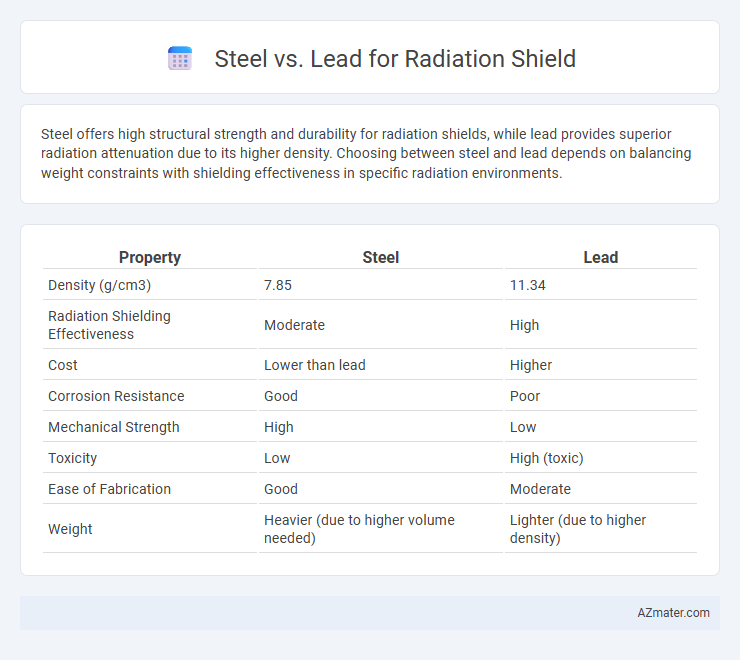Steel offers high structural strength and durability for radiation shields, while lead provides superior radiation attenuation due to its higher density. Choosing between steel and lead depends on balancing weight constraints with shielding effectiveness in specific radiation environments.
Table of Comparison
| Property | Steel | Lead |
|---|---|---|
| Density (g/cm3) | 7.85 | 11.34 |
| Radiation Shielding Effectiveness | Moderate | High |
| Cost | Lower than lead | Higher |
| Corrosion Resistance | Good | Poor |
| Mechanical Strength | High | Low |
| Toxicity | Low | High (toxic) |
| Ease of Fabrication | Good | Moderate |
| Weight | Heavier (due to higher volume needed) | Lighter (due to higher density) |
Introduction to Radiation Shielding Materials
Steel offers high tensile strength and durability, making it suitable for structural radiation shielding applications where mechanical support is critical. Lead provides superior radiation attenuation due to its high density and atomic number, effectively blocking gamma rays and X-rays in compact shielding designs. Selecting between steel and lead depends on the balance between structural requirements and radiation protection efficiency.
Importance of Material Selection in Radiation Protection
Material selection plays a critical role in radiation protection, as the effectiveness of radiation shields depends on the atomic number and density of the material. Lead, with its high atomic number (82) and density (11.34 g/cm3), offers superior attenuation of gamma rays and X-rays compared to steel, which has a lower density (~7.85 g/cm3) and atomic number (26 for iron). However, steel's durability, structural strength, and resistance to corrosion make it preferable in environments requiring mechanical support and long-term stability, while lead is ideal for compact, high-efficiency shielding applications.
Overview of Steel as a Radiation Shield
Steel offers a robust and cost-effective option for radiation shielding, providing high structural strength along with moderate gamma radiation attenuation. Its density, typically around 7.85 g/cm3, allows for effective protection against X-rays and gamma rays, although it requires thicker layers compared to lead to achieve the same level of shielding. Steel's durability, resistance to corrosion, and ease of fabrication make it a preferred choice in medical, industrial, and nuclear applications where mechanical strength and longevity are critical.
Overview of Lead as a Radiation Shield
Lead is a dense metal with a high atomic number (82), making it highly effective at attenuating gamma rays and X-rays in radiation shielding applications. Its dense structure provides superior protection per unit thickness compared to steel, while also offering cost-effective and easy-to-fabricate properties. Despite its toxicity and weight, lead remains the preferred choice in medical and industrial radiation shielding environments due to its excellent radiation absorption capabilities.
Comparative Attenuation Properties: Steel vs Lead
Lead demonstrates superior attenuation properties compared to steel due to its higher atomic number (82) and density (11.34 g/cm3), enabling more effective absorption of gamma rays and X-rays. Steel, with a lower atomic number (26) and density (7.85 g/cm3), requires greater thickness to achieve equivalent radiation shielding, resulting in increased structural weight and volume. The comparative attenuation efficiency directly impacts the design and material selection in radiation protection applications, balancing shielding performance with mechanical strength and cost.
Weight and Structural Considerations
Steel offers a significant advantage over lead in radiation shielding due to its higher structural strength and lower density, resulting in lighter overall weight for the same protective thickness. Its tensile strength allows for thinner, more durable shields that can withstand mechanical stress and maintain structural integrity in construction and transportation. Lead, while denser and providing superior radiation attenuation per unit thickness, requires thicker and heavier designs that pose challenges in support and handling.
Cost Analysis of Steel and Lead Shielding
Steel shielding generally offers a more cost-effective solution for radiation protection compared to lead due to its lower material and fabrication expenses. Lead, while denser and providing superior attenuation per thickness, incurs higher costs related to raw material price, handling, and environmental disposal regulations. Evaluating long-term maintenance and structural support requirements often confirms steel as the economically advantageous choice in large-scale radiation shielding projects.
Environmental and Health Impacts
Steel offers a more environmentally sustainable option for radiation shielding compared to lead due to its recyclability and lower toxicity levels. Lead's high toxicity poses significant health risks during manufacturing, usage, and disposal, often leading to contamination of soil and water sources. Steel's durability and reduced environmental footprint contribute to safer handling and long-term environmental benefits in radiation protection applications.
Application-Specific Recommendations
Steel offers superior structural strength and durability, making it ideal for industrial radiation shielding applications such as nuclear reactors and heavy machinery enclosures. Lead provides higher density and excellent attenuation for gamma and x-ray radiation, preferred in medical imaging rooms and portable radiation protection gear. Selection depends on balancing structural requirements, radiation type, and environmental factors for optimized shielding performance.
Conclusion: Choosing the Right Shielding Material
Steel offers high structural strength and durability for radiation shielding, making it suitable for environments requiring both protection and mechanical support. Lead provides superior radiation attenuation due to its higher density and atomic number, making it the preferred choice for low-space, high-effectiveness applications. Selecting the right shielding material depends on balancing factors such as radiation type, weight constraints, space availability, and budget, with lead excelling in compact efficiency and steel favored for robustness and structural integration.

Infographic: Steel vs Lead for Radiation Shield
 azmater.com
azmater.com